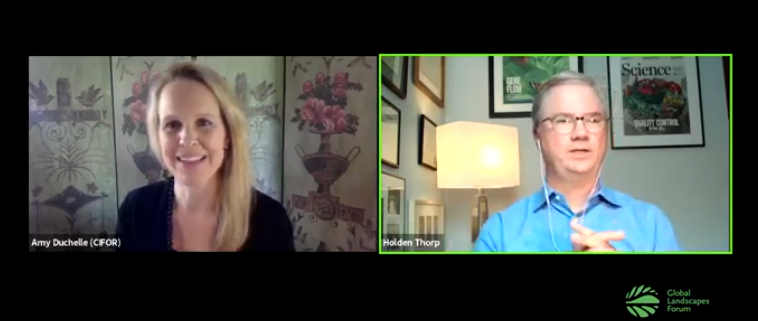
How is the coronavirus like climate change?
Both are invisible to the naked eye, their impacts reverberate around the world, and they are in the crosshairs of critics who question the science behind them and the scientists who are seeking solutions.
“Science is up against a machine of misinformation, and it’s digitally sophisticated and it’s been building for 50 years,” according to Holden Thorp, editor-in-chief of the Science family of journals published by the Washington, D.C.-based American Association for the Advancement of Science.
“Politicians, mainly on the right, found they could score political points by attacking science,” Thorp said last week in conversation with CIFOR climate change lead and senior scientist Amy Duchelle at the all-digital 2020 Global Landscapes Forum, which was broadcast live from Bonn, Germany.
That put scientists on the defensive as they pursue research in areas ranging from gene editing to biodiversity to artificial intelligence, Thorpe said.
Some people question research results because they don’t understand that science involves a constant search for new information, which changes assumptions, he added. That has been painfully evident at times during the COVID-19 pandemic.
With the coronavirus, “people don’t understand that science is a living process carried out by human beings,” Thorp said. “We start out in one place and end up in a different place.”
Early in the pandemic, for example, many experts questioned the effectiveness of face masks and downplayed their use. As evidence mounted that the virus mainly spread through the air, that advice changed, and some countries now require that people wear masks in public places.
“To scientists, [it] makes perfect sense that we would evolve in our understanding,” Thorp said. “Science is just going through its normal course of action.”
But the change gave denialists an opening to say that scientists don’t know what they’re talking about. It was “an opportunity for people to take the normal course of scientific inquiry and use it against us,” he said.
That makes the job of science journalists — both those who work for specialized publications like Science and those who write for a wider audience — especially important now, Thorp said.
While some scientists are also stellar communicators, others shy away from publicity or struggle to put their research into language that ordinary readers can understand, he said.
“We’re very dependent on journalism to provide that bridge between researchers and the public,” Thorp said.
The good news is that surveys show that between 70 and 80 percent of people trust science, he added. At the same time, “that’s scary, because it means that 20 to 30 percent have been convinced by bots and politicians not to trust us.”
Anti-science sentiment has been building for several decades. At the first Earth Day in the 1970s politicians across the political spectrum voiced environmental concerns. By the 1980s, however, that had changed.
“That’s mainly because there was sophisticated polling data [showing] that running against science was a good thing” for candidates, Thorp said. So while scientists must “communicate the best we can, it’s really a political problem.”
Increasingly, scientists are tackling that problem head on, talking about the political implications of their research and calling out falsehoods on social media.
“I’ve decided there’s no reward in trying to stay out of politics,” said Thorp, whose recent editorials have discussed vaccine politics and the crisis of public trust in science. “Borderline autocratic leaders are weaponizing social media to fight against us, so ultimately political change is the only way to beat that back.”
And as protests over police brutality against black people – and the broader structural racism that enables it – have spread around the United States, Brazil and to other countries, scientists are also grappling with issues of discrimination and racism within their own ranks.
“The world of science needs to look in the mirror,” Thorp said. “We’ve done a terrible job of including marginalized populations in science. We don’t send a welcoming message.”
Universities must address problems of abuse and update teaching methods to attract and keep students from diverse backgrounds, ensuring that they have equal opportunities to go on to graduate school and take leadership roles in research and administration, he said. Making more scientific research available in languages other than English is also important.
In the United States, the areas of science that are more likely to attract people of color — such as inequities in health care and the impact of racial disparities in housing and policing — “are historically underfunded,” he added. “You can’t ask for a better example of structural racism than that.”
Like opening up opportunities to marginalized groups, tackling complex issues, from COVID-19 to climate change, will require a combination of science, political action and changes in behavior.
And that’s a challenge for both scientists and science journalists.
“We need to invite [people] to start figuring out new ways to act,” Thorp said. “It’s a mixture of technology and behavior that’s going to solve the climate crisis, and it’s a mixture of technology and behavior that’s going to solve COVID.”
We want you to share Forests News content, which is licensed under Creative Commons Attribution-NonCommercial-ShareAlike 4.0 International (CC BY-NC-SA 4.0). This means you are free to redistribute our material for non-commercial purposes. All we ask is that you give Forests News appropriate credit and link to the original Forests News content, indicate if changes were made, and distribute your contributions under the same Creative Commons license. You must notify Forests News if you repost, reprint or reuse our materials by contacting forestsnews@cifor-icraf.org.